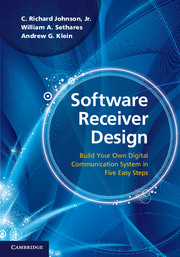Book contents
- Frontmatter
- To the Instructor …
- Contents
- Dedication
- Step 1 The Big Picture
- Step 2 The Basic Components
- Step 3 The Idealized System
- Step 4 The Adaptive Components
- Step 5 Putting It All Together
- Appendices
- A Transforms, Identities, and Formulas
- B Simulating Noise
- C Envelope of a Bandpass Signal
- D Relating the Fourier Transform to the DFT
- E Power Spectral Density
- F The Ƶ-Transform
- G Averages and Averaging
- H The B3IG Transmitter
- Index
H - The B3IG Transmitter
from Appendices
Published online by Cambridge University Press: 05 June 2012
- Frontmatter
- To the Instructor …
- Contents
- Dedication
- Step 1 The Big Picture
- Step 2 The Basic Components
- Step 3 The Idealized System
- Step 4 The Adaptive Components
- Step 5 Putting It All Together
- Appendices
- A Transforms, Identities, and Formulas
- B Simulating Noise
- C Envelope of a Bandpass Signal
- D Relating the Fourier Transform to the DFT
- E Power Spectral Density
- F The Ƶ-Transform
- G Averages and Averaging
- H The B3IG Transmitter
- Index
Summary
In Chapter 9, the Basic Black Box Impairment Generator of Figure 9.22 (on page 187) was described as a routine that transforms a Matlab script specifying the operation of the transmitter into the (received) signal that appears at the input of the receiver. This appendix opens up the black box, shining light on the internal operation of the B3IG.
The B3IG is implemented in Matlab as the routine BigTransmitter.m, and it allows straightforward modeling of any (or all) of the possible impairments discussed throughout Software Receiver Design, including carrier-frequency offset, baud-timing offsets, and frequency-selective and time-varying channels, as well as channel noise. Since many of the impairments and nonidealities that arise in a communication system occur in the channel and RF front end, B3IG is more than a transmitter: it includes the communication channel and receiver RF front end as well. An overview of the B3IG is shown in Figure H.1.
The B3IG architecture expands on the simplified communication system of Chapter 9 and has more options than the M6 transmitter of Chapter 15. Some of the additional features are as follows.
Support for multiple users. The transmitter generates a signal that may contain information intended for more than one receiver.
- Type
- Chapter
- Information
- Software Receiver DesignBuild your Own Digital Communication System in Five Easy Steps, pp. 451 - 459Publisher: Cambridge University PressPrint publication year: 2011



